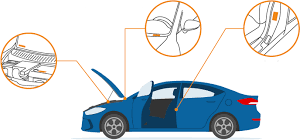What is a Vehicle Identification Number (VIN)?
Sample VIN

A vehicle identification number (VIN), also called a chassis number or frame number, is a unique code, including a serial number, used by the automotive industry to identify individual motor vehicles, towed vehicles, motorcycles, scooters and mopeds, as defined by the International Organization for Standardization. There are vehicle history services in several countries that help potential car owners use VINs to find vehicles that are defective or have been written off.
History
VINs were first used in 1954 in the United States. From 1954 to 1981, there was no accepted standard for these numbers, so different manufacturers and even divisions within a manufacturer used different formats. By 1966, GM had settled on a 13-digit VIN, and standardized its VIN format across its divisions in 1972. In 1981, the National Highway Traffic Safety Administration of the United States standardized the format. It required all on-road vehicles sold to contain a 17-character VIN, which does not include the letters O (o), I (i), and Q (q) (to avoid confusion with numerals 0, 1, and 9). After the introduction of the ISO norm, the manufacturers which produced vehicles for the American market very quickly adjusted to this standard. The ISO introduced recommendations for applying the VIN standard and its structure, and the VIN was also used in Europe. However, the sets of information contained in it were introduced gradually. For example, Volkswagen started to encode bigger chunks of information during 1995–1997, and the control digit during 2009–2015 for selected models from the group. The VIN control digit is also used, although not in all brand-models. In the European vehicles, it can be found e.g. in Audi A1.
VIN Decode Explained
- The first three characters uniquely identify the manufacturer of the vehicle using the world manufacturer identifier or WMI code.
- The fourth to ninth positions in the VIN are the vehicle descriptor section or VDS.
- One element that is inconsistent is the use of position nine as a check digit, compulsory for vehicles in North America and China, but not Europe.
- The 10th to 17th positions are used as the vehicle identifier section or VIS.
- The North American implementation of the VIS uses the 10th digit to encode the model year of the vehicle.

Where Can I Find the VIN?
You can locate the VIN by checking the dashboard on the driver's side. Simply stand outside the vehicle on the driver's side and look at the corner where the dashboard meets the windshield. If not found there, check the door post inside the driver's side door. It's common to find the VIN displayed in this area. Refer to the image below for guidance:

Other VIN Locations:
- Insurance Card
- Insurance Policy
- Vehicle Title and Registration
Drive with Confidence!
Research a Vehicle By VIN Number. Learn more about a vehicle you own or plan to buy.